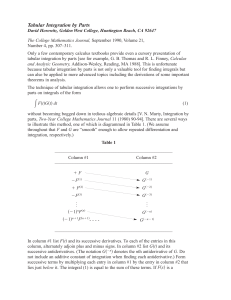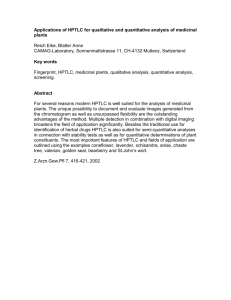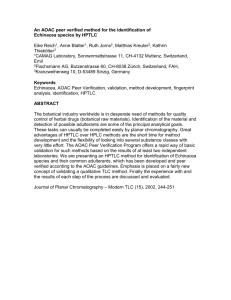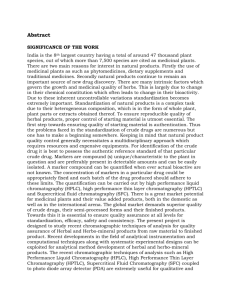Document 13308714
advertisement
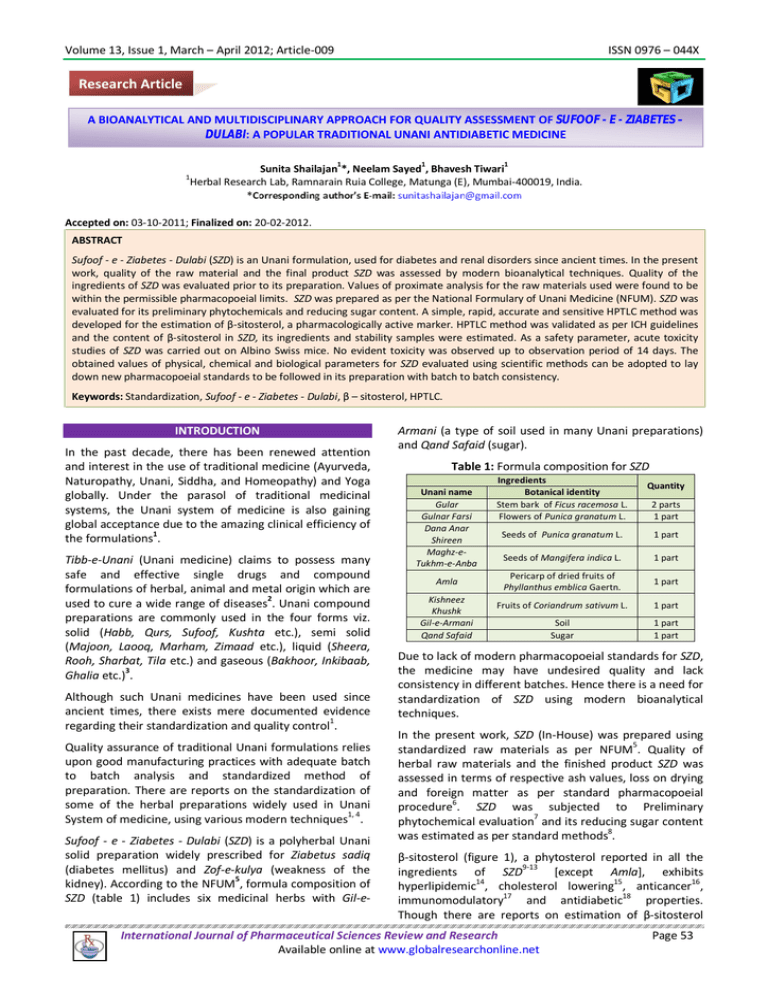
Volume 13, Issue 1, March – April 2012; Article-009 ISSN 0976 – 044X Research Article A BIOANALYTICAL AND MULTIDISCIPLINARY APPROACH FOR QUALITY ASSESSMENT OF SUFOOF - E - ZIABETES – DULABI: A POPULAR TRADITIONAL UNANI ANTIDIABETIC MEDICINE 1 1 1 1 Sunita Shailajan *, Neelam Sayed , Bhavesh Tiwari Herbal Research Lab, Ramnarain Ruia College, Matunga (E), Mumbai-400019, India. Accepted on: 03-10-2011; Finalized on: 20-02-2012. ABSTRACT Sufoof - e - Ziabetes - Dulabi (SZD) is an Unani formulation, used for diabetes and renal disorders since ancient times. In the present work, quality of the raw material and the final product SZD was assessed by modern bioanalytical techniques. Quality of the ingredients of SZD was evaluated prior to its preparation. Values of proximate analysis for the raw materials used were found to be within the permissible pharmacopoeial limits. SZD was prepared as per the National Formulary of Unani Medicine (NFUM). SZD was evaluated for its preliminary phytochemicals and reducing sugar content. A simple, rapid, accurate and sensitive HPTLC method was developed for the estimation of β-sitosterol, a pharmacologically active marker. HPTLC method was validated as per ICH guidelines and the content of β-sitosterol in SZD, its ingredients and stability samples were estimated. As a safety parameter, acute toxicity studies of SZD was carried out on Albino Swiss mice. No evident toxicity was observed up to observation period of 14 days. The obtained values of physical, chemical and biological parameters for SZD evaluated using scientific methods can be adopted to lay down new pharmacopoeial standards to be followed in its preparation with batch to batch consistency. Keywords: Standardization, Sufoof - e - Ziabetes - Dulabi, β – sitosterol, HPTLC. INTRODUCTION In the past decade, there has been renewed attention and interest in the use of traditional medicine (Ayurveda, Naturopathy, Unani, Siddha, and Homeopathy) and Yoga globally. Under the parasol of traditional medicinal systems, the Unani system of medicine is also gaining global acceptance due to the amazing clinical efficiency of the formulations1. Tibb-e-Unani (Unani medicine) claims to possess many safe and effective single drugs and compound formulations of herbal, animal and metal origin which are used to cure a wide range of diseases2. Unani compound preparations are commonly used in the four forms viz. solid (Habb, Qurs, Sufoof, Kushta etc.), semi solid (Majoon, Laooq, Marham, Zimaad etc.), liquid (Sheera, Rooh, Sharbat, Tila etc.) and gaseous (Bakhoor, Inkibaab, 3 Ghalia etc.) . Although such Unani medicines have been used since ancient times, there exists mere documented evidence regarding their standardization and quality control1. Quality assurance of traditional Unani formulations relies upon good manufacturing practices with adequate batch to batch analysis and standardized method of preparation. There are reports on the standardization of some of the herbal preparations widely used in Unani System of medicine, using various modern techniques1, 4. Sufoof - e - Ziabetes - Dulabi (SZD) is a polyherbal Unani solid preparation widely prescribed for Ziabetus sadiq (diabetes mellitus) and Zof-e-kulya (weakness of the kidney). According to the NFUM5, formula composition of SZD (table 1) includes six medicinal herbs with Gil-e- Armani (a type of soil used in many Unani preparations) and Qand Safaid (sugar). Table 1: Formula composition for SZD Unani name Gular Gulnar Farsi Dana Anar Shireen Maghz-eTukhm-e-Anba Amla Kishneez Khushk Gil-e-Armani Qand Safaid Ingredients Botanical identity Stem bark of Ficus racemosa L. Flowers of Punica granatum L. Quantity 2 parts 1 part Seeds of Punica granatum L. 1 part Seeds of Mangifera indica L. 1 part Pericarp of dried fruits of Phyllanthus emblica Gaertn. 1 part Fruits of Coriandrum sativum L. 1 part Soil Sugar 1 part 1 part Due to lack of modern pharmacopoeial standards for SZD, the medicine may have undesired quality and lack consistency in different batches. Hence there is a need for standardization of SZD using modern bioanalytical techniques. In the present work, SZD (In-House) was prepared using standardized raw materials as per NFUM5. Quality of herbal raw materials and the finished product SZD was assessed in terms of respective ash values, loss on drying and foreign matter as per standard pharmacopoeial 6 procedure . SZD was subjected to Preliminary 7 phytochemical evaluation and its reducing sugar content was estimated as per standard methods8. β-sitosterol (figure 1), a phytosterol reported in all the ingredients of SZD9-13 [except Amla], exhibits hyperlipidemic14, cholesterol lowering15, anticancer16, immunomodulatory17 and antidiabetic18 properties. Though there are reports on estimation of β-sitosterol International Journal of Pharmaceutical Sciences Review and Research Available online at www.globalresearchonline.net Page 53 Volume 13, Issue 1, March – April 2012; Article-009 from single herbal drugs and polyherbal formulations using HPLC and HPTLC19-22 but β-sitosterol has not yet been quantified from SZD and its ingredients using HPTLC 20 (except from Maghz-e-Tukhm-e-Anba ). Figure 1: Structure of β-sitosterol ISSN 0976 – 044X Preliminary evaluation phytochemical and physicochemical Phytoconstituents in SZD were evaluated by performing preliminary phytochemical tests for flavonoids, essential oils, tannins, glycosides, alkaloids and resins as per standard methods7. Anthrone method8 was used to determine reducing sugar content of SZD. Chromatographic evaluation HPTLC conditions A simple, sensitive and rapid HPTLC method was developed and validated as per ICH guidelines23 for estimation of β-sitosterol from SZD and its ingredients. Effect of storage on the content of β-sitosterol in SZD samples stored at different storage period was evaluated using HPTLC. The acute oral toxicity of aqueous slurry of SZD was evaluated in Albino Swiss mice using fixed dose 24 procedure . MATERIALS AND METHODS Plant materials Raw materials used for the preparation of SZD were procured from Ratan Gandhi Shop, Mumbai, India and authenticated by Dr. Sunita Shailajan, Ramnarain Ruia College, Mumbai. Materials were dried in oven at 45ᵒC, powdered and sieved through an 85-mesh (BSS) sieve. All the raw materials were stored in an air tight container at ambient temperature prior to SZD preparation. Standard and reagents The organic solvents and chemicals of analytical grade were procured from Qualigens Fine Chemicals, Mumbai, India. Standard β-sitosterol (98% purity) was procured from Sigma-Aldrich Chemie (Steinheim, Germany). Proximate analysis of raw materials 6 Standard pharmacopoeial methods were followed to assess the quality of SZD and its herbal ingredients in terms of proximate parameters like ash values (total ash, acid insoluble ash and water soluble ash), loss on drying and foreign matter. Preparation of SZD Traditional formula composition of SZD is listed in (Table 1). Herbal ingredients of SZD (complying pharmacopoeial quality and quantity) were taken and mixed thoroughly. Gil-e- Armani and Qand Safaid were added to the herbal mixture, mixed well and stored in air tight container till analysis. Inorganic content of Gil-e-Armani was qualitatively evaluated as per standard tests7, prior to preparation of SZD. From the stock of HPTLC plates pre-coated with silica gel 60 F254 (E. Merck) of 0.2 mm thickness with aluminum sheet support, appropriate size of plates were cut and used for chromatographic separation. Samples were spotted using Camag Linomat IV sample applicator (Camag, Switzerland) equipped with syringe (Hamilton, 100.0 µL). Plates were developed in a glass twin trough chamber (Camag) pre-saturated with mobile phase. The developed plates were scanned with Camag TLC Scanner II conjugated with Cats III software. The ambient temperature was maintained at 20 ± 2ᵒC. Sample solution (10.0 µL) was applied in triplicates to the HPTLC plate. The plates were derivatized with 10 % methanolic sulphuric acid and scanned at 366 nm for detection of β-sitosterol. Camag Reprostar 3 system was used for photo documentation. Preparation of standard solutions of β-sitosterol Stock solution of β-sitosterol (1000.0 µg/mL) was prepared in methanol. Aliquots of 10.0 µg/mL-80.0 µg/mL were prepared from the stock solution for calibration curve of β-sitosterol. Three quality control samples (15.0 µg/mL, 27.5 µg/mL and 65.0 µg/mL) were prepared for method validation in terms of system suitability, precision, accuracy and ruggedness. Extraction of Phytoconstituents from SZD and its ingredients Extraction of phytoconstituents from SZD was optimized to achieve good fingerprinting and to resolve the marker compound β-sitosterol efficiently. Different extraction factors, including concentration of solvent, sample– solvent ratio and extraction time were tested and optimized. Finally, one gram each of SZD and its herbal ingredients were subjected to vigorous extraction using 10.0 mL of methanol. Mixture was vortexed for 1-2 minutes and kept standing overnight at room temperature. Next day it was filtered through Whatmann filter paper No. 41 (E. Merck, Mumbai, India), the filtrates were re-filtered through nylon microfilter (0.45 µm, Millipore) and used for HPTLC analysis. Solvent system Each matrix [single plant based drug or formulation (polyherbal or herbo-mineral etc.)] is unique and hence conditions have to be selected to optimize an accurate method in presence of other chemical constituents. Detection and separation of marker compounds was a International Journal of Pharmaceutical Sciences Review and Research Available online at www.globalresearchonline.net Page 54 Volume 13, Issue 1, March – April 2012; Article-009 daunting task from polyherbal formulation like SZD in which six plant ingredients along with soil and sugar have been added. Hence, different solvent systems were tried (from published and unpublished reports on separation of β-sitosterol) and finally solvent system consisting of toluene: ethyl acetate: methanol: glacial acetic acid (8: 1: 5: 0.3, v/v/v/v) was used to resolve and quantify βsitosterol from the matrix of SZD and its herbal ingredients. Method validation ISSN 0976 – 044X and derivatized with 10 % methanolic sulphuric acid for detection of β-sitosterol. Plates were scanned under fluorescence (366 nm) and respective area under curve for β-sitosterol was recorded. Peaks of β-sitosterol were assigned according to the resolution factor of authentic standard and samples under optimized chromatographic condition. Amount of β-sitosterol in SZD and its herbal ingredients was calculated using the regression equation. Recovery ICH guidelines22 were followed for the validation of the developed analytical method for estimation of βsitosterol from SZD and its herbal ingredients. Various parameters assessed during the course of validation were: Accuracy of the method was assessed by performing recovery studies at three different levels (10 %, 25 % and 50 %). Appropriate concentrations of β-sitosterol were spiked into SZD matrix and analyzed. The percent recoveries at each level were calculated to determine average percent recovery. Specificity Ruggedness Specificity was affirmed by analyzing standard compound with sample. The band of β-sitosterol from samples was confirmed by comparing its Rf at three different levels (start, middle, and end positions of the bands) with that from standard. Ruggedness of the method was assessed by deliberately incorporating the small variations in the optimized chromatographic condition. Effect of change in analyst, change in mobile phase composition [toluene: ethyl acetate: methanol: glacial acetic acid (8.1: 1.1: 5.1:0.4 and 7.9: 0.9: 4.9: 0.2 v/v/v/v) and change in spotting volume (9.0 µL and 11.0 µL) on the response and Rf of quality control samples were observed. System Suitability and repeatability System suitability was checked by scanning seven spots of β-sitosterol (5.0 µg/mL, n = 7) and further expressed as relative standard deviation (% RSD). The repeatability of the method was affirmed by scanning five spots of βsitosterol (5.0 µg/mL) and expressed as % RSD. Inter-day and Intra-day precision Variability of the method was studied by analyzing quality control samples of β-sitosterol on the same day (intra-day precision, n = 3) and on three different days (inter-day precision, n = 3). The results were expressed as % RSD. Limit of detection (LOD) and limit of quantitation (LOQ) The limit of detection (LOQ) and limit of quantitation (LOQ) for the developed method was determined by spotting progressively low concentrations of the standard solution of β-sitosterol. Limit of detection (LOD) and limit of quantitation (LOQ) were established at a signal to noise ratio of 3:1 and 10:1 respectively. Linearity Method application The developed HPTLC method was applied further to study the stability of SZD samples stored at different storage period (stored at room temperature) in terms of their respective β-sitosterol content. Safety evaluation Animals Albino Swiss mice of either sex weighing 18-22 g were procured from Haffkine Biopharmaceuticals, Mumbai. All animals were housed in polypropylene cages under standard experimental conditions with 26 ± 20C ambient temperature and 12 h light-dark cycle. The animals were fed standard pellet diet (Amrut laboratory animal feed, India) and were provided water ad libitum. This study was approved by the Institutional Animal Ethics committee (CPSEA/315). Acute toxicity study Linearity (calibration curve) was obtained by analyzing working standard solutions of β-sitosterol at eight different concentration levels (10.0 µg/mL, 20.0 µg/mL, 30.0 µg/mL, 40.0 µg/mL, 50.0 µg/mL, 60.0 µg/mL, 70.0 µg/mL and 80.0 µg/mL). The peak areas and their respective concentration for β-sitosterol were subjected to regression analysis for evaluating the correlation coefficient (r2) and regression equation (y = mx + c) by the least square method.23 Estimation of β-sitosterol from SZD and its ingredients Samples (10.0 µL) were applied in triplicate to HPTLC plates. Plates were developed in mobile phase, air dried In order to evaluate safety of SZD, acute toxicity study (fixed dose procedure, OECD guide lines No. 420)24 was conducted on healthy mice. Mice of either sex (three females and three males) received aqueous slurry of SZD (2.0 g/kg body weight) orally by gavage. A separate group (control) of six mice (three male and three female) received water. The animals were observed for toxic symptoms continuously for the first 4 h after dosing. Finally, the number of survivors was noted after 24 h. These animals were then maintained for further 13 days (total 14 days) with observations made daily for change in body weight, food and water intake. International Journal of Pharmaceutical Sciences Review and Research Available online at www.globalresearchonline.net Page 55 Volume 13, Issue 1, March – April 2012; Article-009 RESULTS AND DISCUSSION Quality assurance is an integral part of all systems of medicine to ensure the quality medicament. Existence of the need to scientifically evaluate quality parameters which can be adopted by the pharmaceutical industries is well supported by the published reports on the standardization of traditional formulations1-4, 25. In current work, modern methods for quality evaluation of the raw materials as well as the finished product of SZD ISSN 0976 – 044X were approached. The results for proximate analysis of herbal raw materials for parameters like ash values (total ash, acid insoluble ash and water soluble ash), loss on drying and foreign matter are represented in table 2. These values were in compliance with the limits documented in the Pharmacopoeia.26 Gil-e-Armani and Qand Safaid were subjected to quality evaluation tests prior to the preparation of SZD. Inorganic content of Gil-eArmani is shown in table 3. Table 2: Proximate analysis of raw materials and SZD, % Mean (n=6) ± SD Sample Gular Gulnar Farsi Dana Anar Shireen Maghz-e-Tukhm-e-Anba Total ash 2.50 ± 0.288 4.50 ± 4.333 3.411 ± 0.057 3.373 ± 0.057 Acid insoluble ash 1.516 ± 0.028 0.246 ± 0.011 0.533 ± 0.057 0.563 ± 0.005 Water soluble ash 1.783 ± 0.028 2.041 ± 0.071 1.459 ± 0.006 1.522 ± 0.038 Loss on drying 9.966 ± 0.557 8.586 ± 0.594 7.860 ± 0.472 7.816 ± 1.901 Foreign matter 0.8733 ± 0.0929 Not observed 0.7200 ± 0.0600 0.6433 ± 0.1721 Amla Kishneez Khushk SZD 3.450 ± 0.005 3.663 ± 0.005 3.373 ± 0.057 1.049 ± 0.010 1.220 ± 0.005 2.339 ± 0.008 0.382 ± 0.004 3.966 ± 0.057 2.227 ± 0.060 7.860 ± 0.472 2.533 ± 0.057 9.988 ± 0.595 0.1040 ± 0.0205 Not observed Not applicable Table 3: Qualitative evaluation of Gil-e-Armani for its inorganic content Inorganic component Results Sulphate + Chloride + Carbonate + Nitrate Sodium + (+) indicates presence while (-) indicates absence Standard Operating Procedure (SOP) for the preparation of SZD as per NFUM5 is documented in the current work. SZD was found to be enriched with essential oils, tannins, glycosides, flavonoids and alkaloids as per the preliminary phytochemical tests. Presence of these major secondary metabolites in SZD may attribute to its therapeutic efficacy and assures its traditional use. Similar results for preliminary phytochemicals have been reported for some 1-4, 24 popular traditional formulations used in India . Reducing sugar content of SZD, estimated using Anthrone method was 0.38 ± 0.003 %. Table 4: β – sitosterol content in ingredients of SZD β – sitosterol content (mg/g) Ingredients [Mean (n=3) ± S. D.] Gular 0.626 ± 0.0076 Gulnar Farsi 1.186 ± 0.0175 Dana Anar Shireen 1.603 ± 0.0155 Maghz-e-Tukhm-e-Anba 0.44 ± 0.0069 Amla 0.583 ± 0.0111 Kishneez Khushk 1.535 ± 0.0199 In the present work, β-sitosterol content in SZD and its herbal ingredients was estimated using HPTLC for the first time (table 4 and table 5) although estimation of βsitosterol from herbal raw materials and formulations is common. Among the various solvent systems tried, mixture containing toluene: ethyl acetate: methanol: glacial acetic acid (8: 1: 5: 0.3 v/v/v/v) resulted in proper resolution of β-sitosterol (Rf = 0.49) from the plant matrix which enabled its quantification using HPTLC (figure 2). Table 5: Stability study of SZD Storage period β – sitosterol content (mg/g) (Months) [Mean (n=3) ± S. D.] 0 1.057 ± 0.0188 1 1.055 ± 0.0156 2 1.057 ± 0.0102 3 1.056 ± 0.0058 Figure 2: HPTLC Detection of β-sitosterol from SZD and its ingredients at 366 nm HPTLC fingerprints from methanolic extracts of SZD and its ingredients; 1: Gular, 2: Gulnar farsi, 3: Dana Anar Shireen, 4: Maghz-e-Tukhm-eAnba, 5: Amla, 6: Kishneez Khushk, 7: SZD, 8: β-sitosterol Phytochemical fingerprints (through chromatographic techniques) of finished product and its ingredients are quite often used by the pharmaceutical industry to examine the source of the drug substance and the method of preparation. Such fingerprints are strongly recommended for the purpose of quality control of herbal medicines, since they represent the “chemical integrities” International Journal of Pharmaceutical Sciences Review and Research Available online at www.globalresearchonline.net Page 56 Volume 13, Issue 1, March – April 2012; Article-009 of herbal medicines. Phytochemical finger prints for SZD and its ingredients are represented in figure 2. Bands related to the ingredients of SZD were found in the HPTLC fingerprint pattern of SZD. The method was validated as per the current norms of ICH guidelines and results are presented in (Table 6). Method was found to be precise (% RSD value were < 2 % for Intra-day and Inter-day precision) (table 7), sensitive (LOD and LOQ were 2.0 µg/mL and 4.0 µg/mL respectively), rugged (% difference were within the range of ± 5 % for ruggedness parameters) and yielded 94.12 ± 1.6527 % recovery of β-sitosterol (table 8) from complex matrix of formulation. The content of β-sitosterol in SZD will provide a baseline data to trace the variations in quality of SZD (batch-to-batch variations) manufactured by different manufacturers. Phytochemical finger prints of stability samples are represented in figure 3. Table 6: Method validation parameters for β – sitosterol Parameters Results System suitability (% RSD, n = 5) 1.72 Instrumental precision (% RSD, n = 7) 1.54 Linear Working Range (µg/mL) 10.0 to 80.0 Regression equation y = 28.89x - 107 Correlation coefficient (r2) 0.995 LOD (µg/mL) 2.0 LOQ (µg/mL) 4.0 Specificity Specific Ruggedness Rugged ISSN 0976 – 044X Table 7: Precision studies for β – sitosterol Intra-day Inter-day Concentration (µg/mL) (% RSD) (% RSD) 15.0 0.07 0.83 27.5 0.12 0.96 65.0 0.17 1.09 Figure 3: Stability samples of SZD on HPTLC at 366 nm Stability samples of SZD stored at different storage conditions; 1: 0 month sample, 2: β-sitosterol, 3: 1 month sample, 4: 2 month sample, 5: 3 month sample Stability samples of SZD stored at different storage periods (0 month, 1 month, 2 month and 3 month) were subjected to HPTLC evaluation to estimate respective βsitosterol content. Variation within the acceptance criteria for β-sitosterol content in stability samples (table 5) indicated that, SZD is stable for at least three months of storage conditions. The results of stability studies are supported by the frequent references in Unani pharmaceutical methods regarding use of Sufoof. Table 8: Recovery studies for β – sitosterol from SZD Amount of β – sitosterol Recovery Accuracy Present in SZD Added in SZD Amount found (%) (average % recovery) (µg/mL) (µg/mL) (µg/mL) 52.83 0 50.13 94.89 52.83 5.283 54.11 93.11 94.12 ± 1.6527 52.83 13.21 61.04 92.43 52.83 26.42 76.12 96.05 In acute toxicity studies, no significant change in body weight, food intake and water intake of the animals was observed compared to animals of control group and no mortality was recorded too. Thus, at the doses empirically used in traditional medicine, the formulation, at least its aqueous slurry (2.0 g/kg body weight of animals), could be considered with a wide margin of safety for oral use. Since toxicity in humans cannot always be entirely extrapolated from animal studies, clinical evaluation should be performed to precisely define the safe dosage. Such reproducible modern techniques can make the traditional Unani medicines more acceptable in the local and global market. Thus rationally designed, carefully standardized, synergistic traditional formulations and botanical drug products with robust scientific evidence can be used as an alternative to modern medicine. CONCLUSION Results of the present study can be used to characterize the samples in industry to check their uniformity. The obtained values of physical, chemical and biological parameters for SZD can be adopted to lay down new pharmacopoeial standards to be followed in its preparation with batch to batch consistency. A routine use of such scientific techniques will lead to standardization of the Unani medicine to a certain extent and would definitely help in building confidence in use of these products. International Journal of Pharmaceutical Sciences Review and Research Available online at www.globalresearchonline.net Page 57 Volume 13, Issue 1, March – April 2012; Article-009 ISSN 0976 – 044X 14. Best MM, Duncan CH, Modification of abnormal serum lipid patterns in atherosclerosis by administration of sitosterol, Annals of Internal Medicine. 45, 1956, 614-22. 15. Afzal M, Khan NA, Ghufran A, Iqbal A, Inamuddin M, Diuretic and nephroprotective effect of Jawarish Zarooni Sada - a polyherbal Unani formulation, Journal of Ethnopharmacology, 91, 2004, 21923. Becker M, Staab D, Von Bergmann K, Long-term treatment of severe familial hypercholesterolemia in children: Effect of sitosterol and bezatibrate, Pediatrics, 89, 1992, 138-42. 16. Awad, AB, Chen YC, Fink CS, Hennessey T, Beta-sitosterol inhibits HT-29 human colon cancer cell growth and alters membrane lipids, Research, 16(5A), 1996, 2797-804. 3. Dubey N, Dubey N, Mehta RS, Saluja AK, Jain DK, Quality assessment of Kushta-e-Gaodanti: a traditional Unani medicine, Asian Journal of Research in Chemistry, 1(1), 2008, 46-50. 17. 4. Shailajan S, Yeragi M, Purohit A, Optimized separation and quantification of eugenol from a traditional Unani medicine Jawarish-e-Bisbasa using HPTLC, International Journal of Pharmaceutical Sciences Review and Research, 9(1), 2011, 14651. Desai F, Ramanathan M, Fink CS, Wilding GE, Weinstock-Guttman B, Awad AB, Comparison of the immunomodulatory effects of the plant sterol beta-sitosterol to simvastatin in peripheral blood cells from multiple sclerosis patients, International journal of Immunopharmacology, 9(1), 2009, 153-57. 18. Jamaluddina F, Mohamed S, Lajis MN, Hypoglycaemic effect of Parkia speciosa seeds due to the synergistic action of β-sitosterol and Stigmasterol, Food Chemistry, 49(4), 1994, 339-45. 19. Shah S, Shailajan S, Quantitation of β-sitosterol from Woodfordia fruiticosa (Linn) Kurz and a polyherbal formulation used in the treating female reproductive disorders, Analalytical Chemistry: An Indian Journal, 8(1), 2009, 82-6. REFERENCES 1. 2. Ajazuddin SS, Evaluation of physicochemical and phytochemical properties of Safoof-e-Sana, a Unani polyherbal formulation, Pharmacognosy Research, 2(5), 2010, 318-322. 5. National Formulary of Unani Medicine (NFUM), Government of India, Department of Indian System of Medicine and Homeopathy, Part-II, The Controller of Publications Civil Lines, New Delhi, 2000, 89. 6. Indian Pharmacopoeia (IP), Government of India, Ministry of th Health and Family Welfare, 6 ed, Vol I, The Indian Pharmacopoia Commission, Gaziabad, 2010, 82-201. 20. Dhara R, Bhattacharyya DK, Ghosh M, Analysis of sterol and other components present in unsaponifiable matters of mahua, sal and mango kernel oil, Journal of Oleo Science, 59(4), 2010, 169-76. 7. Khandelwal KR, Practical Pharmacognosy Techniques and th Experiments, 19 ed, Nirali prakashan publishers, Pune, 2008, 149-157, 159, 169. 21. 8. Lindsay H, A colorimetric estimation of reducing sugars in potatoes using 3, 5-dinitro salicylic acid, Potato Resrarch, 16, 1973, 176-79. Shailajan S, Shah S, Sayed N, HPTLC method development and validation of a secondary metabolite – β - sitosterol from Caesalpinia bonduc (Linn.) Roxb. Emend. Dandy & Exell. Seeds, International Journal of Pharma and Biosciences, 1(3), 2010, 1-10. 22. Shailajan S, Joshi H, Optimized separation and quantification of pharmacologically active markers Quercetin, Kaempferol, βsitosterol and Lupeol from Cuscuta reflexa Roxb. Journal of Pharmacy Research, 4(6), 2011, 1851-53. 23. International Conference on Harmonization (ICH), Validation of analytical procedures: methodology, ICH harmonized tripartite guideline, 1998. <http://www.hc-sc.gc.ca/hpb-dgps/therapeut> Accessed 04-06-2011. 24. The Organization of Economic Co-operation Development (OECD), The OECD Guideline for Testing of Chemical: 420 Acute Oral Toxicity, Paris, 2001, 1–14. 25. Shailajan S, Singh A, Tiwari B, Quality control and standardization of an Ayurvedic Taila formulation, International Journal of Biomedical Research and Analysis, 1(2), 2010, 78-81. 26. The Ayurvedic Pharmacopoeia of India (API), Government of India, Department of Indian System of Medicine and st Homeopathy, Part I, 1 ed, Vol II, The Controller of Publications Civil Lines, New Delhi, 1999. 9. Joseph B, Raj SJ, Phytopharmacological and phytochemical properties of three Ficus species - an overview, International Journal of Pharma and Bio Sciences, 1(4), 2010, 246-53. 10. Karmarkar UK, Rahman MA, Roy DN, Sandhu SK, Ali ME, Chemical and biological investigations of Coriandrum sativum Linn, International Journal of Pharmaceutical Sciences and Research, 2(4), 2011, 999-1006. 11. Ali Z, Siddiqui HL, Mahmud S, Waheed A, Hameed S, 4, 4dimethylsterols, 4-methylsterols and 4-demethylsterols of Mangifera indica kernel fat, Pakistan Journal of Scientific Research, 60(1-2), 2008, 34-39. 12. 13. Ahmed R, Ifzal SM, Saifuddin A, Mohammad N, Studies on Punica Granatum - isolation and identification of some constituents from the seeds of Punica Granatum, Pakistan Journal of Pharmaceutical Science, 8(1), 1995, 69-71. Wang R, Wang W, Wang L, Liu R, Ding Y, Du L, Constituents of the flowers of Punica granatum, Fitoterapia, 77, 2006, 534–37. ********************** International Journal of Pharmaceutical Sciences Review and Research Available online at www.globalresearchonline.net Page 58
